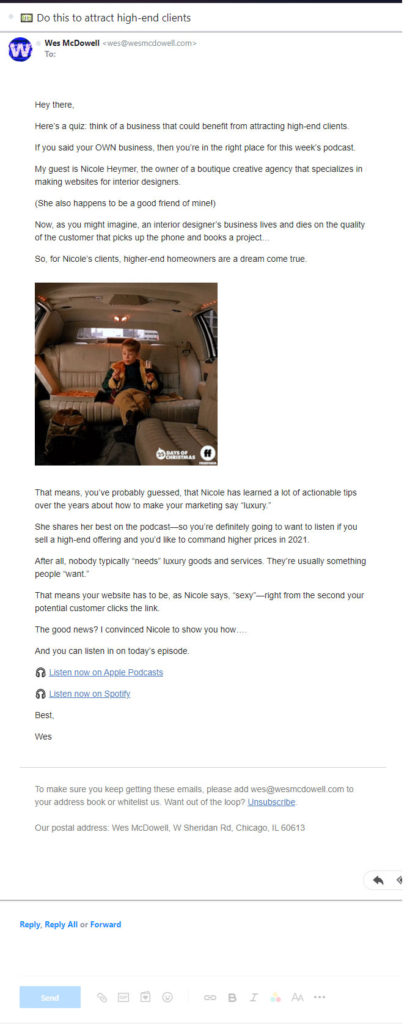There are dozens of different email marketing campaigns that could be sent to your email subscribers, but which ones are an absolute must? The short answer is that it depends on your type of business and services, but here are some you’ll want to consider using with examples.
#1 – Newsletters / Promotional Emails
Promotional emails are where the money is. Whenever you have something new to sell to your email lists, like a hot new product or a Black Friday sale, these are your go-to emails.

For these emails to be successful, you need to consider a lot of things that go from building your email list with qualified leads to optimizing your email campaigns for conversions.
The goal of promotional emails is simple, to generate results quickly. If you offer a service, you can invite your subscribers to a free consultation call. If you have an eCommerce business, you can notify them of a new, limited-time offer on a brand new product line.
Other types of promotional emails include automation, like cart abandonment reminders. Ecommerce businesses often have these types of emails in place to try to recover as many abandoned carts as possible with minimal effort.
You can also send invitational emails, which may involve in-person meetings or live streams so that you can introduce something new and exciting in your industry. These emails can allow you to build trust by connecting directly with your audience on a personal level.
Promotional emails are subject to the CAN-SPAM Act in the United States, which prompts you to be more careful and follow similar local laws for your email recipients. For example, you should always include your business’s complete mailing address, and an unsubscribe link at your emails’ footer. You should also get permission from your subscribers before emailing them to avoid spam filters and complaints.
#2 – Nurturing Emails
If the product or services you sell are on the higher end of the scale in pricing, then nurturing emails is a great choice. These types of emails aim to essentially build a relationship with your audience so that you can slowly build enough trust to turn cold email leads into potential buyers.

For instance, if you collect leads via a blog page on your website, these leads are typically at the top of the sales funnel or customer journey. If you immediately start sending them an offer to buy something, chances are you won’t be successful.
To succeed with nurturing emails, you will want to guide your email subscribers on the buyer’s journey. You can start by sending valuable information on a subject where they have shown interest. You can follow up by creating a more in-depth guide or bringing in industry experts on a podcast you share with them as a follow-up. Establishing this connection will allow you to drive a successful nurturing campaign.
You can also use other initiatives that can be just as effective, like a pre-sale or offer a considerable discount for only a limited time. These offers can put customers in the consideration stage to become paid customers or qualified leads.
Another option is using automated lead nurturing email campaigns. For example, suppose someone signs up to download an ebook on your website. You can send the ebook right away and automatically follow up within a few days with additional resources that supplement the ebook they just downloaded. Finally, you may have a final email that sells your product or services with a discount that should align with the initial materials you sent to the customer.
Like MailChimp, the most popular email marketing platforms allow you to build these strategic email sequences that automatically lead your cold email subscribers into paid customers.
#3 – Transactional Emails
Transactional emails can come in the form of a payment notification which goes out automatically to anyone with whom you have conducted business. If you have an online business and accept online payments, you can send your subscribers messages when an item is shipped. These are transactional emails.

Unlike your traditional email marketing messages, which involve a promotion, these emails are exempt from most provisions of the CAN-SPAM act; this is primarily because the primary intent of the message isn’t commercial.
It’s good to keep in mind that these email recipients may not necessarily want to receive marketing messages. However, they still want to get important information about any recent transactions they have had with your business.
For example, nearly everyone who leaves their email address during check out when purchasing a product online expects to be notified by email with order updates. But unless they signed up to receive email marketing messages, they are not necessarily expecting your promotional emails. For this reason, you should give your customers an option as to whether they would like to receive marketing emails during the checkout process.
Please keep in mind that the CAN-SPAM act, in particular, applies to the United States; if you send emails to customers in other countries, be sure to stay informed about local laws.

